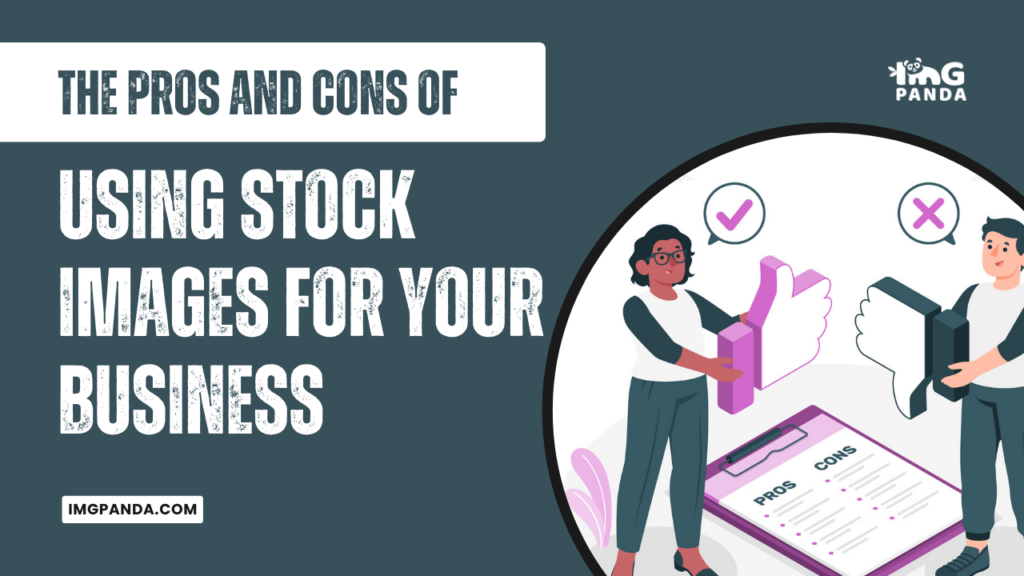Introduction:
In today's visually-driven digital landscape, the choice of imagery can significantly impact how your business is perceived by the world. Many entrepreneurs and marketers turn to stock images as a valuable resource for enhancing their online presence and marketing materials. Yet, this convenience comes with its own set of considerations.
In this blog post, we embark on a journey to explore the pros and cons of using stock images for your business. We will delve into the advantages that stock images bring, such as time and cost savings, along with their potential drawbacks, including issues related to uniqueness and authenticity.
By the end of this discussion, you'll have a comprehensive understanding of how to harness the power of stock images effectively while navigating the potential pitfalls they may present. Whether you're a seasoned business owner or just starting, this exploration will equip you with the insights needed to make informed decisions about incorporating stock imagery into your branding and marketing strategy.
Also Read This: How to Download Dailymotion Videos Easily and Quickly
Pros of using stock images for your business:
Cost-effective:
Cost-effective refers to a measure of the efficiency of a particular course of action, product, or service, where the benefits achieved are greater than the costs incurred. In other words, it means that a certain action or investment is considered worthwhile because it provides benefits that are greater than the costs associated with it.
[caption id="attachment_192841" align="alignnone" width="1500"] Pros of using stock images for your business:[/caption]
Pros of using stock images for your business:[/caption]
For example, using stock images for a business can be considered cost-effective because the cost of purchasing or licensing the images is much lower than the cost of hiring a professional photographer or graphic designer to create custom visuals. However, it's important to consider the quality and uniqueness of the images when assessing their cost-effectiveness, as using low-quality or overused stock images may not provide the same benefits as high-quality, unique images. Ultimately, the cost-effectiveness of a particular action or investment depends on the specific context and goals of the business or individual.
Wide variety:
Wide variety refers to a diverse range of options or choices available for selection. In the context of stock images, a wide variety means that there are numerous options of images available for purchase or licensing, covering a broad range of subjects, styles, and formats.
Having a wide variety of stock images to choose from can be beneficial for businesses as it allows them to select images that are suitable for their specific needs and preferences. For example, a business looking to create marketing materials for a new product launch may need images that showcase the product in different settings, such as on a white background, in use by customers, or in different angles. With a wide variety of stock images available, the business can easily find images that meet these requirements without having to hire a photographer or spend time creating their own visuals.
However, it's important to note that having a wide variety of stock images available does not necessarily mean that all of the images are of high quality or suitable for every purpose. It's essential to carefully review and select images that fit the needs of the business and align with its branding and messaging.
Time-saving:
Time-saving refers to the ability of a particular action, product, or service to reduce the amount of time needed to complete a task or achieve a goal. In the context of using stock images for a business, the availability of pre-existing images that can be purchased or licensed can save a significant amount of time compared to creating custom visuals.
[caption id="attachment_192842" align="alignnone" width="1500"] Time-saving[/caption]
Time-saving[/caption]
For example, if a business needs an image to use in their website or marketing materials, they can spend hours or even days creating their own image or hiring a photographer to create one for them. With stock images, however, they can quickly search through a wide variety of pre-existing images to find one that meets their needs and license or purchase it in a matter of minutes. This time-saving benefit can be particularly valuable for businesses with tight deadlines or limited resources.
It's important to note that while using stock images can be a time-saving option, it's still essential to review and select high-quality images that align with the brand and messaging of the business. Rushing to select an image without proper consideration can result in a poor quality image that does not meet the needs of the business, which can ultimately waste time and resources in the long run.
Legal protection:
Legal protection refers to the legal rights and remedies that are available to protect an individual or business from potential legal issues or disputes. In the context of using stock images for a business, legal protection refers to the ability of the business to use the images without infringing on any copyrights or other legal rights.
Using stock images can provide legal protection to a business in several ways. First, stock image providers typically offer licenses or agreements that grant businesses the right to use the images for specific purposes, which can help ensure that the business is not infringing on any copyrights or other legal rights. Additionally, reputable stock image providers typically have processes in place to ensure that the images they offer are not infringing on any existing copyrights or other legal rights.
Also Read This: Fixing YouTube Issues on Your iPhone
Cons of using stock images for your business:
Lack of uniqueness:
Lack of uniqueness refers to the fact that stock images are often used by multiple businesses or individuals, which can result in a lack of originality or uniqueness in the visuals used by businesses.
[caption id="attachment_192843" align="alignnone" width="1500"] Cons of using stock images for your business[/caption]
Cons of using stock images for your business[/caption]
Using stock images can result in a lack of uniqueness for a business in several ways. First, since the images are pre-existing and available to anyone who purchases or licenses them, multiple businesses or individuals may end up using the same images, which can result in a lack of differentiation or originality in the visuals used by businesses. This can be particularly problematic for businesses that are looking to establish a unique brand identity or stand out from their competitors.
Additionally, some stock images may be overused or have become cliche, which can result in a lack of originality or creativity in the visuals used by businesses. For example, using a stock image of a handshake or a globe may be overused and not convey the unique value proposition of a business.
To overcome the lack of uniqueness associated with using stock images, businesses can take steps to ensure that the images they select are high-quality and align with their brand and messaging. Additionally, businesses can consider using a combination of stock images and custom visuals to create a more unique and differentiated visual identity.
Lower quality:
Lower quality refers to the fact that some stock images may not meet the same standards as custom visuals or images created by professional photographers or graphic designers.
While many stock images are of high quality, some may have lower resolution, poor lighting or composition, or other quality issues that can make them less effective or visually appealing. This can be particularly problematic for businesses that are looking to create a professional and high-quality image for their brand.
Additionally, some stock images may not be suitable for certain uses, such as large-format printing or digital advertising, which can result in lower quality or pixelated images.
To overcome the lower quality associated with using stock images, businesses can take steps to carefully review and select high-quality images that meet their specific needs and align with their brand and messaging. Additionally, businesses can consider working with a professional designer or photographer to create custom visuals or enhance stock images to meet their specific needs.
Difficulty in finding the perfect image:
Difficulty in finding the perfect image refers to the challenge that businesses may face when searching for a specific image that meets their exact needs and specifications. While stock image libraries offer a wide variety of images, it can sometimes be difficult to find the perfect image that meets all the requirements of the business. Below is a video of Pros and Cons of Using stock Images:
For example, a business may be looking for a specific image that aligns with their brand colors, messaging, and visual style, but may not be able to find an image that meets all of these criteria. Additionally, some businesses may have very specific or niche requirements that may not be available in stock image libraries.
To overcome the difficulty in finding the perfect image, businesses can take steps to carefully research and review stock image libraries to find the images that best meet their needs. They can also consider working with a designer or photographer to create custom visuals that align with their brand and messaging. Additionally, businesses can consider using a combination of stock images and custom visuals to create a more unique and differentiated visual identity.
Overuse:
Overuse refers to the fact that some stock images may be used frequently by many businesses, resulting in them becoming ubiquitous or cliché. This can make it difficult for businesses to stand out and differentiate themselves from their competitors.
For example, certain stock images like handshakes, lightbulbs, and globes have become cliché and overused in the business world, to the point where they may not effectively convey a business's unique value proposition or brand identity.
Overuse can be particularly problematic for businesses that are looking to establish a unique and memorable brand identity or create visuals that stand out in a crowded market.
To overcome overuse, businesses can take steps to carefully review and select stock images that are not overused or cliché. They can also consider using a combination of stock images and custom visuals to create a more unique and differentiated visual identity. Additionally, businesses can work with a designer or photographer to create custom visuals that effectively convey their brand identity and unique value proposition.
"Stock images can be a cost-effective and time-saving solution for businesses looking to enhance their visual content. However, they can also lack uniqueness, lower quality, and be overused, making it important for businesses to carefully review and select the images that best align with their brand and messaging."
Also Read This: How to Watch Dailymotion on Firestick and Access Videos on Your TV
Pros and Cons:
| Pros | Cons |
|---|---|
| 1. Cost-effective | 1. Lack of originality |
| 2. Easy access | 2. Poor quality or irrelevant images |
| 3. Saves time | 3. Overuse of common images |
| 4. Wide range of options | 4. Risk of legal issues or copyright infringement |
Also Read This: Discounts for Your Stock Image Purchases: Alamy Coupon Code Offers
Conclusion:
In conclusion, using stock images for businesses can have both advantages and disadvantages. On the one hand, they are cost-effective, time-saving, and offer a wide variety of images to choose from. They also provide legal protection and can be a useful solution for businesses with limited resources or time.
On the other hand, using stock images can result in a lack of uniqueness, lower quality, and difficulty in finding the perfect image. Overuse of certain stock images can also make it difficult for businesses to differentiate themselves from their competitors.
Therefore, businesses should carefully weigh the pros and cons of using stock images and take steps to ensure that the images they select align with their brand and messaging. This can include carefully reviewing and selecting high-quality images, using a combination of stock and custom visuals, and working with designers or photographers to create custom visuals that effectively convey their unique value proposition and brand identity.
FAQ:
What is a stock image?
A stock image is a photograph or illustration that is made available for commercial use by licensing to individuals or businesses. Stock images are often used in advertising, marketing, and other forms of visual content creation.
Why do businesses use stock images?
Businesses use stock images as a cost-effective and time-saving solution to enhance their visual content. Stock images are also a useful solution for businesses with limited resources or time.
Are stock images high quality?
While many stock images are of high quality, some may have lower resolution, poor lighting or composition, or other quality issues that can make them less effective or visually appealing.
How can businesses avoid using overused stock images?
To avoid using overused stock images, businesses can take steps to carefully review and select images that are not overused or cliché. They can also work with designers or photographers to create custom visuals that effectively convey their unique value proposition and brand identity.
Can businesses use stock images for any purpose?
While stock images are typically available for commercial use, businesses should carefully review the licensing agreements for each image to ensure that they are using them in accordance with the terms of the agreement. Additionally, some stock images may not be suitable for certain uses, such as large-format printing or digital advertising.
